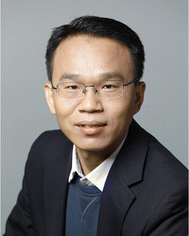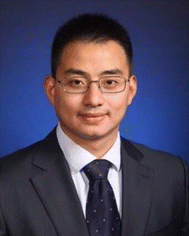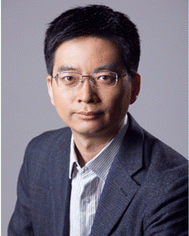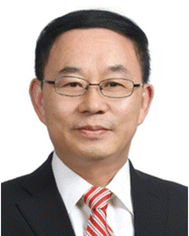Celebrating the 20th anniversary of the National Center for Nanoscience and Technology, China (NCNST)
Xinfeng
Liu
 *ae,
Qing
Dai
*ae,
Qing
Dai
 *b,
Zhixiang
Wei
*b,
Zhixiang
Wei
 *ce,
Chunying
Chen
*ce,
Chunying
Chen
 *de and
Yuliang
Zhao
*de and
Yuliang
Zhao
 *de
*de
aCAS Key Laboratory of Standardization and Measurement for Nanotechnology, National Center for Nanoscience and Technology, Beijing 100190, China. E-mail: liuxf@nanoctr.cn
bCAS Key Laboratory of Nanophotonic Materials and Devices, National Center for Nanoscience and Technology, Beijing 100190, China. E-mail: daiq@nanoctr.cn
cCAS Key Laboratory of Nanosystem and Hierarchical Fabrication, CAS Center for Excellence in Nanoscience, National Centre for Nanoscience and Technology, Beijing 100190, China. E-mail: weizx@nanoctr.cn
dCAS Key Laboratory for Biomedical Effects of Nanomaterials & Nanosafety, CAS Center for Excellence in Nanoscience, National Center for Nanoscience and Technology, Beijing 100190, China. E-mail: chenchy@nanoctr.cn
eUniversity of Chinese Academy of Sciences, Beijing 100049, China. E-mail: zhaoyl@nanoctr.cn
The National Center for Nanoscience and Technology, China (NCNST), established in December 2003, is co-founded by the Chinese Academy of Sciences (CAS) and the Ministry of Education as an institution dedicated to fundamental and applied research in the field of nanoscience and technology, especially those with important potential applications. NCNST is operated under the supervision of the Governing Board and aims to become a world-class research center, as well as public technological platform and young talents training center in the field, and to act as an important bridge for international academic exchange and collaboration.
The NCNST currently has three CAS Key Laboratories: the CAS Key Laboratory for Biological Effects of Nanomaterials & Nanosafety, the CAS Key Laboratory for Standardization & Measurement for Nanotechnology and the CAS Key Laboratory for Nanosystem and Hierarchical Fabrication. In 2020, construction of the CAS Key Laboratory of Nanophotonic Materials and Devices started. There is also the Division of Nanotechnology Development, Nanofabrication Laboratory, Intelligent Nano-sensing Laboratory and Theoretical Laboratory. With the rapid development in the past two decades, NCNST has built a strong research team, with 99 full professors and 110 associate professors, including 3 CAS academicians, 15 Distinguished Young Scholars and 26 Excellent Young Scholars from the National Natural Science Foundation of China.
Over the past twenty years, NCNST has made important progress in basic research, applied basic research and technical support systems, and its scientific and technological competitiveness has been significantly improved. In 2014 the International Evaluation Committee applauded the significant achievements and outstanding contributions in nanoscience, and remarked that NCNST had risen to a position of “by far the best in China”. In recent years the Nature Index showed that NCNST had been one of the “Top 10 Institutes of CAS”.
The high impact academic journals on nanoscience and nanotechnology – Nanoscale, Nanoscale Advances and Nanoscale Horizons – are a collaborative venture between NCNST and the Royal Society of Chemistry. In celebration of the 20th anniversary of NCNST, the Royal Society of Chemistry organized this special cross-journal collection, which features 32 articles to showcase the recent research progress in a wide spectrum of nanoscience and nanotechnology from NCNST, including advanced nanocharacterization and simulation, micro/nano functional devices, nanomaterials for energy and catalysis, and nanobiotechnologies and nanomedicine.
In the field of advanced nanocharacterization and simulation, Prof. Liming Xie et al. summarize the recent progress on the in situ imaging of 2D material growth to reveal the growth rate, kink dynamics, domain coalescence, growth across the substrate steps, and single-atom catalysis (https://doi.org/10.1039/D3NR01475D). Prof. Qiang Zheng et al. directly visualize and quantify inherent local fluctuating lattice distortions with short-range ordering behavior in four types of high-entropy oxides in real-space by means of scanning transmission electron microscopy imaging (https://doi.org/10.1039/D3NR05176E). Using first-principles calculations, Prof. Lizhi Zhang et al. estimate a series of d/p-type magnetic adatoms and predict a giant magnetic anisotropy energy up to 157/313 meV induced by the synergistic effect of the ligand field and significant spin–orbit coupling interaction of the Pb/Bi adatom with z/x(y)-axis magnetization (https://doi.org/10.1039/D3NR01943H).
In the field of nanomaterials and functional device development, Prof. Yong Yan et al. summarize the four levels of in-sensor computing in artificial olfactory research; discussing the integration of sensing, storage, and computing as well as the exploration of sensing mechanisms, processing algorithms, and integration methods, (https://doi.org/10.1039/D3NH00115F). Prof. Yaling Liu et al. introduce the design, development and trend for SERS-active nanomaterials from single component to two or more components, benefiting their complete understanding and enhancing research enthusiasm on them (https://doi.org/10.1039/D3NR01456H). Prof. Bin Wang et al. summarize the development history of diamane, and mainly focus on the experimental results associated with the synthesis processes and several key properties obtained by theoretical simulations (https://doi.org/10.1039/D3NR01400B). Prof. Yong Zhang et al. report an all-physical top-down method for the production of quantum-sized, monolayer topological insulators/semimetals which demonstrates their ultrahigh and broadband saturable absorption (https://doi.org/10.1039/D3NH00282A). Prof. Lianfeng Sun and Prof. Weiguo Chu et al. report that a non-zero, gate-tunable Hall resistance Rxy can be obtained using a Hall bar on monolayer graphenes with edge bonded electrodes, revealing the existence of the anomalous Hall effect (AHE) which is usually presumed to be absent in pristine graphene due to its diamagnetism (https://doi.org/10.1039/D3NH00233K). Prof. Guanglu Ge et al. develop a wearable sensor for sweat glucose detection with ultrahigh sensitivity and wide linear detection (https://doi.org/10.1039/D3NR05179J). Prof. Pengfei Duan et al. develop chiral nanofibers by combining supramolecular symmetry-breaking and fluorescence resonance energy transfer, resulting in the emergence of near-infrared circularly polarized luminescence with a substantial dissymmetry factor value (https://doi.org/10.1039/D3NR01515G). Prof. Xiaochun Wu et al. studied the roles of non-chiral cationic surfactants in tuning the helical growth of plasmonic nanostructures and exhibited surfactant-modulated conversion of the chiral shell deposition mode between layer growth and island growth. Their findings demonstrate the promising potential of nanochemical synthesis in fabricating chiral plasmonic nanostructures with small structural sizes (https://doi.org/10.1039/D3NR01371E).
In the field of nanomaterials for energy and catalysis, Prof. Huiqiong Zhou et al. review the remarkable advances of quasi-2DDJ perovskites for solar cells and provide a perspective toward their future development (https://doi.org/10.1039/D3NH00209H). Prof. Xiangnan Sun et al. underline recent advances in external spin injection and organic property-induced spin polarization, according to the distinction between the sources of spin polarization (https://doi.org/10.1039/D3NH00101F). Prof. Zhiyong Tang et al. report a nano assembly strategy of MOFs to implement double excellence in catalytic activity and chiral selectivity for enantioretentive epoxide activations (https://doi.org/10.1039/D3NH00419H). Prof. Xianglong Li et al. present a direct foaming method to facilitate lithium ion transport throughout laminated silicon–graphene hybrid electrodes, enabling remarkably enhanced lithium storage performance along with maximized silicon utilization (https://doi.org/10.1039/D3NR02840B). Prof. Zhixiang Wei et al. present a straightforward strategy to construct high-efficiency ternary organic solar cells with low Eloss by incorporating a high open-circuit voltage small molecule acceptor Qx2 into the PM6:m-BTP-PhC6 blend. The best PCE of 18.60% was achieved in the optimal ternary devices due to the synergistic enhancement of parameters (https://doi.org/10.1039/D3NH00122A). Prof. Qian Liu et al. develop a fine laser doping strategy based on highly controllable laser direct writing, and realize power-gradient laser doping and patterned laser doping, for the first time, for designable energy band structures in 2D materials (https://doi.org/10.1039/D3NR00808H). Prof. Kun Lu et al. synthesized three non-fullerene acceptors (NFAs) based on the modification of a quinoxaline central core. It is found that fine-tuning the central core size can effectively influence the molecular geometry and their device energy loss and power conversion efficiency (https://doi.org/10.1039/D3NR05077G). Prof. Tao He et al. report that the photocatalytic activity of Au–n-Si (Au–p-Si) samples is lower than that of Au–TiO2–n-Si (Au–TiO2–p-Si), and Au–SiO2 is lower than Au–TiO2–SiO2 and Au–n-Si (Au–p-Si) samples, suggesting that here the direct electron transfer mechanism is dominant compared with the plasmon resonant enhancement effect (https://doi.org/10.1039/D3NR02543H).
In the field of nanobiotechnologies and nanomedicine, Prof. Tianjiao Ji et al. introduce specific interaction-based drug loading strategies either inspired by the interactions between drugs and their targets, or inspired by the interactions from life processes. These strategies could provide insight for constructing nanoscale drug delivery systems (https://doi.org/10.1039/D3NH00165B). Prof. Rong Yang et al. give an overview of the recent progress in MXene-based nanozymes, with emphasis on their synthetic methods, hybridization, bio-catalytic properties, and biomedical applications (https://doi.org/10.1039/D3NH00213F). Prof. Shuaidong Huo et al. introduce the recent progress in the biophysical mechanism governing the interaction between ultrasound and cell membranes, with significant implications for drug delivery and nanomedicine (https://doi.org/10.1039/D3NR02562D). Prof. Xuejing Cui et al. reviewed the mesenteric history and highlight the importance of the mesentery in health and disease, with a focus on the biological effects of nanomaterials on the mesentery (https://doi.org/10.1039/D3NR02494F). Prof. Jiashu Sun et al. introduce the fundamental principles of microfluidic systems in nanomaterials synthesis, and summarize system features, biological applications, current challenges, and future directions (https://doi.org/10.1039/D3NH00217A). Prof. Ying Liu et al. present a review on the healing mechanism and existing therapies of fibrocartilaginous enthesis injury. The nanofibrous scaffold has been proposed to mimic the natural structure and morphology to promote the repair of fibrocartilaginous enthesis by controlling the morphology and ensuring controlled drug release (https://doi.org/10.1039/D3NH00212H). Prof. Hai Wang et al. describe the biological barriers and some targeting strategies for nanoparticles to target specific organs. The design of selective targeting nanoparticles for various organs is illustrated, which provides a reference strategy for studying the design of selective organ targeting nanoparticles (https://doi.org/10.1039/D3NH00145H). Prof. Xingjie Liang et al. provide an overview of the nanostructures of natural and engineered Chinese herbal medicines, including extracted CHMs, polymer nanoparticles, liposomes, micelles, and nanofibers. They summarize the future opportunities and major challenges in the formulation of nanostructures for CHM therapies. They also discuss the challenges and perspectives of applying RNA-cleaving DNAzyme as a diagnostic and therapeutic medicine (https://doi.org/10.1039/D3NH00120B, https://doi.org/10.1039/D3NR01482G). Prof. Zengying Qiao et al. develop a strategy for cell membrane-specific self-assembly based on peptide nanomedicine, to induce tumor immunogenic death in cancer therapy, providing a new reference for cancer immunotherapy (https://doi.org/10.1039/D3NH00173C). Prof. Qiaojun Fang et al. report an easily engineered magnetotactic bacteria MVs-based nanosystem demonstrating augmented antitumor therapy by synergizing chemotherapy, ferroptosis, and immunotherapy (https://doi.org/10.1039/D3NH00061C). Prof. Yuliang Zhao and Prof. Chunying Chen et al. investigate how the chirality of nanoparticles affects protein corona formation and further interaction with cell receptors. These interactions determine the distinct cell uptake and tissue accumulation, highlighting the importance of chirality in targeted nanomedicine design (https://doi.org/10.1039/D3NH00124E). Prof. Dong Han et al. investigate interstitial fluid flow using a synthesized high-relaxivity MRI contrast agent, PAA-g-(DTPA-gadolinium). This enables precise tracking of nanoscale particles in the long-distant interstitial stream, facilitating advancements in physiological, pathological, and pharmacological research (https://doi.org/10.1039/D3NA00118K).
Due to space limitations, this themed issue cannot include any further progress. These representative achievements celebrate the 20th anniversary of the establishment of the NCNST by all researchers and students. We hope to work together with experts and scholars in various fields to promote the development of nanoscience and technology, meet the major needs of society, achieve more transformation, and strive for scientific and technological progress to help people's health and national strategic development, as we continue to write a new 20 years of nanotechnology. Last but not least, we would like to express our appreciation to Dr Guanqun Song and Dr Yanhong Ma for their contributions and efforts to this themed issue. Sincere thanks to all authors, reviewers, and editorial staff for their hard work and dedication!
| This journal is © The Royal Society of Chemistry 2024 |





